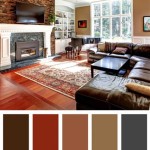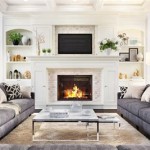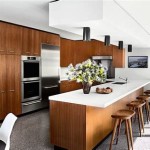Neutral Living Room Decor Ideas: A Comprehensive Guide
The living room serves as a central hub in many homes, a space for relaxation, entertainment, and social gatherings. Decorating this space requires careful consideration of aesthetics, functionality, and personal preferences. Neutral color palettes offer a versatile foundation for living room décor, providing a calming atmosphere while allowing for flexibility with accents and evolving styles. This article explores various neutral living room decor ideas, examining the principles of color theory, material selection, and design strategies that contribute to a harmonious and inviting living space.
Understanding Neutral Color Palettes
Neutral colors are those that lack strong saturation and generally serve as a backdrop against which more vibrant colors can be showcased. This category encompasses a wide range of hues, including whites, beiges, grays, creams, and browns. While often perceived as understated, neutral palettes are not devoid of complexity. They possess subtle undertones that can significantly impact the overall feeling of a room. For instance, a warm neutral, such as beige with a yellow undertone, will create a cozier and more inviting atmosphere compared to a cool neutral, like gray with a blue undertone. The deliberate selection of neutral tones is therefore crucial to achieving the desired aesthetic impact.
When selecting a neutral color palette, one must consider the existing architectural elements of the room. Natural light, the color of flooring, and the presence of fixed features like fireplaces or built-in shelving units all influence how neutral colors are perceived. A room with ample natural light can handle cooler neutrals without appearing stark, while a room with limited natural light benefits from warmer neutrals to avoid a feeling of coldness. It is recommended to test paint swatches in the room under varying lighting conditions before making a final decision. This allows one to observe how the color shifts throughout the day and ensures that the chosen neutral complements the existing environment.
The concept of a monochrome palette, utilizing various shades of a single neutral color, provides a sophisticated and elegant approach to living room design. By employing different textures and materials within the same color family, it is possible to create visual interest without resorting to contrasting colors. For example, a living room featuring various shades of gray could incorporate a light gray sofa, a medium gray rug, and dark gray accent pillows, all with varying textures to add depth and dimension to the space. This technique relies on subtle variations in value and texture to prevent the room from appearing flat or monotonous.
Key Elements in Neutral Living Room Decor
Successful neutral living room decor relies on a careful balance of elements working in harmony. These elements include furniture selection, textiles, accessories, and lighting.
Furniture: The selection of furniture is paramount to defining the style and function of the living room. In a neutral setting, the shapes and textures of the furniture become particularly important. Opting for furniture pieces with clean lines and classic silhouettes creates a timeless aesthetic. Consider the scale of the furniture in relation to the size of the room; oversized pieces can overwhelm a small space, while undersized pieces might appear lost in a larger room. Upholstered furniture in neutral fabrics, such as linen, cotton, or wool, provides comfort and visual appeal. It is advisable to select fabrics that are durable and easy to clean, especially in high-traffic areas.
Textiles: Textiles play a significant role in adding warmth and texture to a neutral living room. This includes rugs, throws, pillows, and curtains. A rug in a natural fiber, such as jute or sisal, can anchor the space and add a tactile element. Throws and pillows in varying textures, such as knit, velvet, or faux fur, can create a cozy and inviting atmosphere. Curtains in a light and airy fabric, such as linen or sheer cotton, can soften the natural light and add a touch of elegance. The strategic use of patterns, even in neutral tones, can add visual interest without overwhelming the space. Consider incorporating subtle geometric patterns or textured weaves in rugs, pillows, or curtains.
Accessories: Accessories provide opportunities to personalize the living room and add pops of color or texture. Artwork, decorative objects, and plants can be used to create a cohesive and visually appealing display. When selecting artwork, consider the scale and color palette. Large-scale artwork can serve as a focal point, while smaller pieces can be grouped together to create a gallery wall. Decorative objects, such as vases, bowls, and sculptures, can add character and personality to the space. Plants bring life and freshness to the living room, and their green foliage provides a natural contrast against the neutral backdrop. It's important to keep the accessories balanced and uncluttered, focusing on quality over quantity.
Lighting: Lighting is essential for creating the desired mood and ambiance in the living room. A combination of ambient, task, and accent lighting is recommended. Ambient lighting provides overall illumination, while task lighting focuses on specific areas, such as reading nooks. Accent lighting highlights artwork or architectural features. Floor lamps, table lamps, and recessed lighting can be used to create a layered lighting scheme. The use of dimmer switches allows one to adjust the lighting levels to suit different activities and moods. Opting for light fixtures with neutral finishes, such as brushed nickel, matte black, or brass, complements the overall aesthetic.
Design Strategies for Effective Neutral Living Rooms
Beyond selecting individual elements, the overall design strategy plays a crucial role in creating a successful neutral living room. Key considerations include space planning, balance and symmetry, and the incorporation of natural elements.
Space Planning: Effective space planning ensures that the living room is both functional and aesthetically pleasing. Consider the flow of traffic and the intended use of the space when arranging furniture. Create distinct zones for conversation, relaxation, or entertainment. Arrange furniture in a way that promotes interaction and creates a sense of openness. Avoid overcrowding the space with too much furniture, and ensure that there is ample room to move around. A well-planned space feels comfortable and inviting, encouraging people to gather and relax.
Balance and Symmetry: Balance and symmetry contribute to a sense of harmony and order in the living room. Symmetrical arrangements, where elements are mirrored on either side of a central axis, create a formal and balanced look. Asymmetrical arrangements, where elements are balanced but not identical, create a more relaxed and informal feel. Whether opting for a symmetrical or asymmetrical arrangement, it is important to maintain a sense of visual balance. This can be achieved by distributing weight and color evenly throughout the room. The skillful use of negative space, or empty areas, can also enhance the sense of balance and prevent the room from feeling cluttered.
Incorporating Natural Elements: Introducing natural elements into the living room enhances its warmth and vitality. Natural materials, such as wood, stone, and plants, add texture and visual interest. A wooden coffee table, a stone fireplace, or a collection of potted plants can bring the outdoors in and create a connection to nature. Natural light is also essential for creating a welcoming and comfortable atmosphere. Maximize natural light by using sheer curtains and strategically placing mirrors to reflect light throughout the room. The incorporation of natural elements softens the overall aesthetic and adds a sense of tranquility to the living space.
Ultimately, creating a successful neutral living room involves a careful consideration of color theory, material selection, and design strategies. By understanding the nuances of neutral colors, selecting appropriate furniture and accessories, and implementing effective design principles, it is possible to create a living space that is both stylish and inviting.

13 Neutral Living Room Ideas

Discover 35 Stunning And Modern Neutral Living Room Designs

13 Neutral Living Room Ideas For Your Home Swyft

Before After Sleek Neutral Living Room Design Decorilla

Neutral Living Room Ideas From Stars Latest Show Star And Celebrity News
Why Neutral Living Room Designs Are The Popular Choice This Spring Inspirations Essential Home

15 Dreamy Neutral Living Rooms Room Decor Design

35 Neutral Living Room Ideas That Are Anything But Plain

35 Neutral Living Room Ideas That Are Anything But Plain

75 Stylish Neutral Living Room Designs Digsdigs







